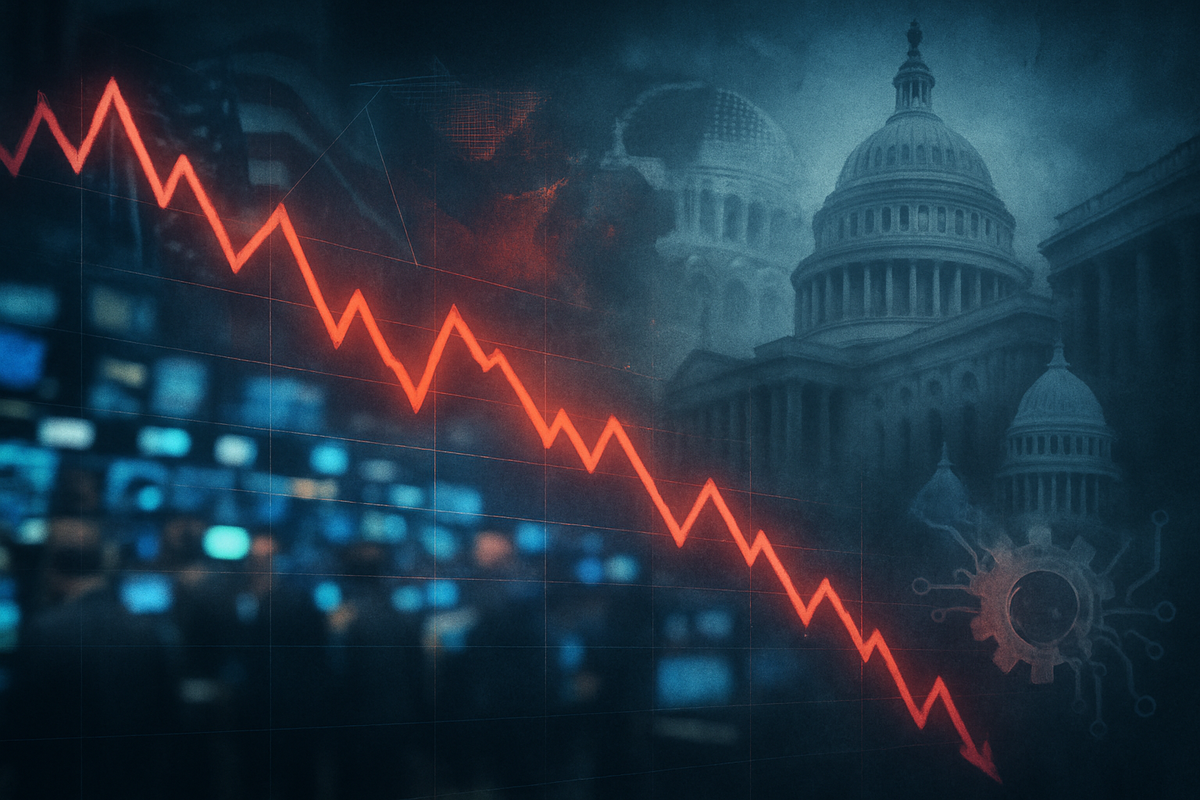
New York, NY – October 10, 2025 – U.S. equity markets experienced a dramatic downturn today, with both the S&P 500 and Nasdaq Composite indices recording substantial losses, shattering a months-long period of relative calm on Wall Street. The decline was fueled by a confluence of potent factors: renewed U.S.-China trade tensions, escalating concerns over AI stock valuations, an ongoing U.S. government shutdown, and persistently rising bond yields. This sharp market correction has left investors grappling with uncertainty, as the immediate implications point to increased volatility and a fundamental reassessment of market drivers.
The S&P 500 fell by 0.8%, closing down by approximately 18 points, while the tech-heavy Nasdaq Composite slid by nearly 2%, ending the day down by about 18.75 points at 23,024.63. This significant sell-off pushed major indexes into negative territory for the week, ending a streak of gains and signaling a profound shift in investor sentiment. The immediate fallout includes a widespread retreat from growth-oriented technology stocks and a scramble for safe-haven assets, highlighting a fragile market grappling with a perfect storm of economic and geopolitical headwinds.
The Perfect Storm: Unpacking the Market's Sharp Decline
The market's retreat on October 10, 2025, was not a singular event but the culmination of several powerful forces converging simultaneously. The primary catalyst was the sudden escalation of trade hostilities between the U.S. and China. President Donald Trump's threat of a "massive increase" in tariffs on Chinese imports, directly following China's tightened export controls on rare earth minerals and an antitrust investigation into Qualcomm (NASDAQ: QCOM), reignited fears of a "Trade War 2.0." This announcement sent shockwaves through global supply chains, particularly impacting technology and manufacturing sectors heavily reliant on international trade.
Adding to the trade-induced anxiety were mounting concerns over the valuations of artificial intelligence (AI) driven technology stocks. A growing chorus of warnings from major financial institutions, including the Bank of England, IMF, Goldman Sachs (NYSE: GS), and JPMorgan (NYSE: JPM), highlighted stretched valuations in the AI sector, drawing comparisons to the dot-com bubble of 2000. While AI stocks like Nvidia (NASDAQ: NVDA) and AMD (NASDAQ: AMD) have shown remarkable resilience and continued to drive Nasdaq momentum, the market's reassessment of these high valuations contributed significantly to the tech-heavy index's decline. Reports of "circular deals" within the AI ecosystem have further intensified scrutiny on profitability in the AI cloud space.
Further exacerbating market anxiety is the ongoing U.S. government shutdown, now in its tenth day. This political impasse has delayed the release of crucial economic data, such as the September payrolls report and the Consumer Price Index (CPI), leaving investors "flying blind" to some extent regarding the health of the U.S. economy. This information vacuum, coupled with fears of its potential impact on GDP growth and federal worker furloughs, further frayed investor sentiment and contributed to the widespread sell-off.
Finally, persistently high and recently surging bond yields also played a significant role in the market's decline. The 10-year Treasury yield spiked, making lower-risk fixed-income investments increasingly attractive compared to equities. Higher borrowing costs for companies can weigh on corporate profits and cash flows, leading investors to rebalance portfolios away from stocks and into bonds, especially impacting growth and AI infrastructure stocks. This combination of trade tensions, AI valuation concerns, political gridlock, and rising interest rates created a "perfect storm" that caught many investors by surprise after a period of relative calm.
Shifting Fortunes: Winners and Losers in a Volatile Market
In the wake of such a significant market downturn, driven by a multifaceted array of pressures, the landscape for public companies and entire sectors is undergoing a rapid re-evaluation. While the broad market suffers, certain segments are poised for greater resilience or even potential gains, while others face significant headwinds.
Defensive sectors are typically the first port of call for investors seeking stability during turbulent times. Companies producing essential goods and services, such as consumer staples, utilities, and healthcare, tend to exhibit more stable demand regardless of economic conditions. Giants like Procter & Gamble (NYSE: PG), Coca-Cola (NYSE: KO), PepsiCo (NASDAQ: PEP), Walmart (NYSE: WMT), and Johnson & Johnson (NYSE: JNJ) often hold up well due to their strong brand power and steady revenue streams. Similarly, utility providers and telecommunication companies like Verizon Communications (NYSE: VZ) offer essential services, providing more predictable cash flows.
A unique "winner" in this scenario, directly stemming from the renewed U.S.-China trade tensions, could be domestic rare earth mineral companies. With China implementing tighter export controls on these critical materials, U.S. producers such as MP Materials (NYSE: MP) and USA Rare Earth could see a surge in demand and stock prices as markets price in supply chain disruptions and a strategic shift towards domestic sourcing. Conversely, the high-growth technology and AI-related firms, which have fueled much of the recent market rally, are now facing intense pressure. Overvaluation concerns, coupled with rising bond yields that disproportionately hurt growth stocks by increasing the discount rate for future earnings, are causing significant losses for major tech players like Nvidia (NASDAQ: NVDA), AMD (NASDAQ: AMD), Meta Platforms (NASDAQ: META), Amazon (NASDAQ: AMZN), and Tesla (NASDAQ: TSLA).
Industries highly sensitive to trade tensions, particularly those with complex global supply chains, are also set to lose. This includes consumer electronics, automotive, and semiconductor manufacturers, all of whom face increased production costs, tariffs, and potential export restrictions. Furthermore, interest-rate sensitive sectors like real estate and construction are vulnerable, as higher mortgage rates strain affordability and increase borrowing costs for developers. Consumer discretionary companies, which rely on robust consumer spending, will also feel the pinch as economic uncertainty and higher credit costs lead to reduced purchases of non-essential goods. Finally, government contractors face direct revenue loss from the ongoing U.S. government shutdown, as they are typically not guaranteed backpay unlike federal employees.
A Broader Ripple: The Wider Significance of the Downturn
The decline in the S&P 500 and Nasdaq Composite on October 10, 2025, extends far beyond mere stock price movements; it signals profound shifts in broader industry trends, global economic stability, and the policy landscape. The tech sector, which accounts for a significant portion of the S&P 500, is particularly exposed, with concerns over AI valuations drawing stark comparisons to the dot-com bubble of 2000. This suggests a potential re-evaluation of market sustainability and a shift from relentless growth to a greater emphasis on underlying fundamentals and macroeconomic stability.
The ripple effects on the global economy are substantial. Renewed U.S.-China trade tensions, including tariffs and export controls on critical minerals, are expected to cause significant global supply chain disruptions. This could lead to increased costs, delays, and a pressing need for companies to diversify their sourcing or even relocate production. Such geopolitical alignment-driven trade patterns could reshape global commerce. Furthermore, a decline in major U.S. indices often signals a wider global economic slowdown, affecting trade and investment flows worldwide, and potentially leading to reduced consumer and business confidence across international markets.
From a regulatory and policy perspective, the situation presents a complex challenge. The Federal Reserve faces increased scrutiny, as the government shutdown delays the release of crucial economic data, making it difficult to guide monetary policy decisions regarding interest rate cuts. This information vacuum, combined with mixed signals from Fed officials, adds to market uncertainty. The U.S. government shutdown itself highlights political gridlock and fiscal instability, which could erode investor confidence in U.S. governance and its fiscal reputation globally. Renewed trade tensions will necessitate active policy responses, potentially accelerating efforts by Western nations to develop alternative supply chains for critical materials. Moreover, concerns about an "AI bubble" could lead to increased regulatory scrutiny on the AI sector, focusing on valuations, business models, and potential systemic risks.
Historically, the current confluence of factors has precedents. The dot-com bubble serves as a cautionary tale for AI valuations. Past government shutdowns have introduced short-term volatility, but a prolonged one, as seen now, can shave off a portion of quarterly GDP and delay crucial economic data. The U.S.-China trade war under the Trump administration in early 2025 also led to widespread panic selling and significant revisions of corporate profit expectations, demonstrating the severe market impact of such tariffs. While rising interest rates can limit growth stock valuations, the current multi-factor downturn creates a more complex and potentially severe scenario, drawing parallels to historical crashes like the 2020 pandemic crash or Black Monday in 1987, underscoring the need for robust risk management.
Navigating the Headwinds: What Comes Next
The current market environment, characterized by a significant decline in the S&P 500 and Nasdaq Composite due to renewed trade tensions, AI valuation concerns, a government shutdown, and rising bond yields, sets a challenging course for the coming months and years. The immediate outlook is one of heightened volatility and cautious sentiment, with short-term possibilities pointing to continued market instability.
In the short term, the market is expected to remain highly sensitive to news regarding U.S.-China trade relations, with any further tariff threats or retaliatory measures likely to trigger additional sell-offs. The ongoing government shutdown will continue to inject uncertainty by delaying economic data and potentially weighing on job growth if prolonged. Scrutiny on AI valuations will intensify, and any reassessment of these high-flying stocks could lead to rapid corrections. Rising bond yields will continue to exert liquidation pressure, particularly on growth and chipmaker stocks, as the Federal Reserve's stance on interest rates remains a critical determinant. In this climate, a flight to safe-haven assets like gold, which has surged past $4,000 per ounce, is likely to persist.
Looking further ahead, the long-term trajectory will largely depend on the resolution of these multifaceted headwinds. The U.S.-China rivalry is expected to remain complex, implying ongoing disruptions in global supply chains and a strategic competition for critical mineral resources. While short-term corrections in the AI sector are possible, the long-term demand for AI infrastructure and advancements is anticipated to continue, though the focus might shift from speculative growth to tangible profitability. The U.S. economy has shown underlying resilience in certain areas, and historically, the S&P 500 has demonstrated strong long-term returns even after periods of stress. A resolution to the government shutdown and a clearer monetary policy path from the Fed could pave the way for a more stable recovery.
Companies are likely to implement strategic pivots to adapt to this challenging environment. Supply chain diversification and reshoring efforts will accelerate to mitigate geopolitical risks. AI companies may shift from hyper-growth strategies to emphasize profitability and sustainable business models. Cost management and operational efficiency will become paramount due to rising bond yields and economic uncertainty. Strategic alliances, mergers, and acquisitions might become more frequent to gain access to critical technologies or consolidate market share. Emerging markets face a mixed bag of challenges from trade tensions and rising U.S. bond yields, but opportunities may arise through diversification, strengthened policy frameworks, and the formation of new regional trading blocs. The most likely scenario is a grinding, uneven recovery, characterized by elevated volatility and cautious investor sentiment, preventing a swift rebound.
A New Era of Market Vigilance: The Road Ahead
The market's sharp decline on October 10, 2025, marks a critical juncture, signaling an end to a period of relative calm and ushering in an era of heightened market vigilance. The confluence of renewed U.S.-China trade tensions, concerns over AI valuations, a prolonged government shutdown, and rising bond yields has created a complex and challenging landscape for investors and corporations alike.
The key takeaways from this tumultuous day underscore the fragility of market sentiment and the interconnectedness of global economic and political factors. The warnings from global financial bodies about a potential AI bubble highlight the systemic risks associated with overheated valuations, while the rekindling of trade wars threatens to disrupt global supply chains and corporate earnings for the foreseeable future. The government shutdown, a domestic political issue, has amplified uncertainty by obscuring vital economic data.
Moving forward, the market is poised for continued volatility, with a likely re-evaluation of growth strategies and a greater emphasis on profitability over speculative expansion. The lasting impact could be a more diversified investment approach, less reliant on a few dominant tech companies, and a heightened awareness of geopolitical risks.
Investors in the coming months should meticulously monitor the Q3 corporate earnings season for insights into how companies are navigating rising costs and trade tensions. The resolution of the U.S. government shutdown is paramount, as it will unlock crucial economic data needed to assess economic health and guide Federal Reserve actions. Any further developments in U.S.-China trade relations will be a primary driver of market direction, as will shifts in the Federal Reserve's monetary policy and the trajectory of interest rates. Finally, a close scrutiny of AI sector fundamentals, focusing on underlying profitability and adoption rates, will be critical to gauge the sustainability of the tech rally. Beyond these, global GDP growth, inflation rates, and geopolitical stability will remain vital indicators for navigating the uncertain road ahead.
This content is intended for informational purposes only and is not financial advice





